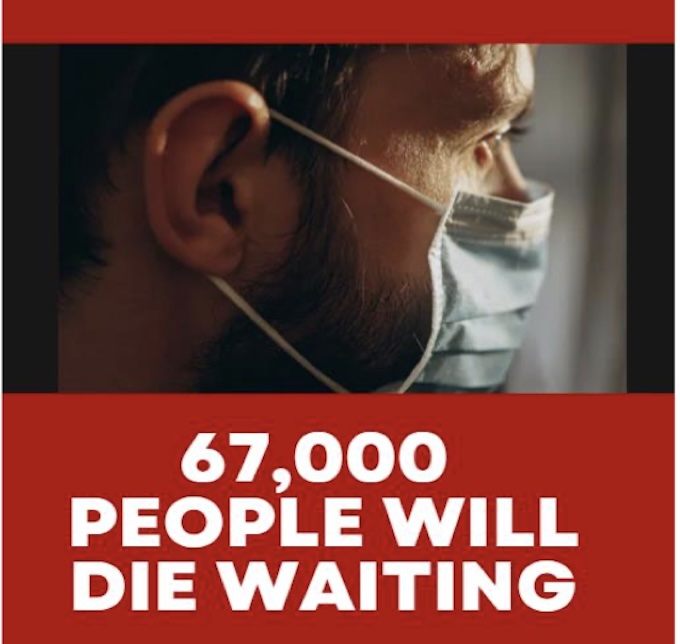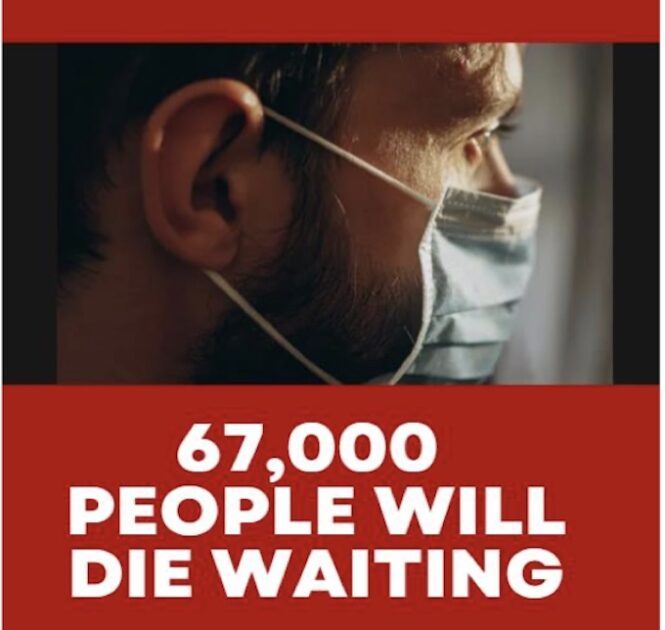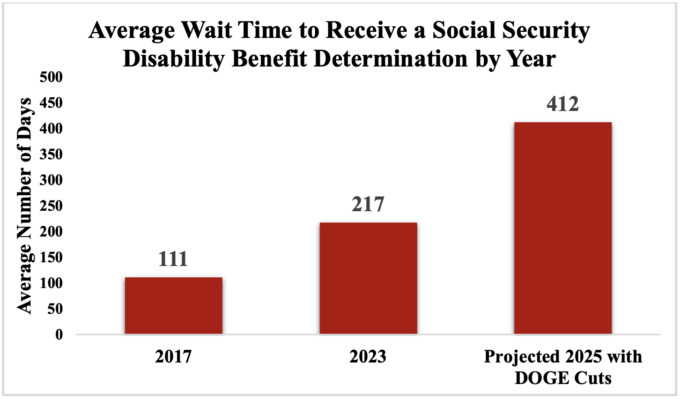






























































Minority Staff Report, United States Senate, SUBCOMMITTEE ON SOCIAL SECURITY, PENSIONS, AND FAMILY POLICY, Bernie Sanders, Ranking Member, March 26, 2025
Social Security is the most successful government program in our nation’s history. For more than 86 years, through good times and bad, Social Security has paid out every benefit owed to every eligible American on time and without delay. Social Security lifts roughly 27 million Americans out of poverty each and every year.i And yet, despite this success, we can do better. We must do better. At a time of massive wealth inequality, our job must be to expand and strengthen Social Security.
Americans across both parties agree with this sentiment. Roughly 87 percent agree that Social Security should remain a top priority for Congress—no matter the state of budget deficits.ii This is unsurprising since Americans view Social Security as a lifeline. In this country, half of older Americans have no retirement savings and have no idea how they will ever be able to retire with any shred of dignity or respect.iii One in three seniors, or roughly 17 million people, are economically insecure.iv Roughly 22 percent of seniors are trying to survive on an income of less than $15,000 a year and nearly half of seniors are trying to survive on an income of less than $30,000 a year.v
These numbers are even more startling for people with disabilities. Nearly 27 percent of people with disabilities live in poverty.vi Living with a disability involves extra costs, requiring families to spend an estimated 28 percent more income to maintain the same standard of living as non- disabled people, or roughly an additional $17,690 annually.vii For a person with a disability on Supplemental Security Income (SSI), the maximum support they receive is just $11,604 annually for individuals and $17,400 for couples.viii And for people on Social Security Disability Insurance (SSDI), the average annual benefit is $18,972.ix Millions of people with disabilities are living paycheck to paycheck and certainly do not have the necessary resources to cover additional costs of living with a disability.
Nor do they have the time to wait for their disability benefits. Yet, the number of Social Security Administration (SSA) staff completing disability determinations began declining even before the Department of Government Efficiency (DOGE). In 2023, there were 5,252 full time employees making disability determinations at SSA, which has steadily decreased from previous years.x The average wait time for a decision grew from 111 days in 2017 to 217 days in 2023. Even before this Administration started making cuts to SSA, the number of people who died waiting for a benefit decision grew from 10,000 to 30,000 from 2017 to 2023.xi In February 2025, there was an average 236 day wait time for a determination.xii
Yet, instead of focusing on delivering benefits to seniors and people with disabilities, President Trump and unelected billionaire Elon Musk are systematically dismantling SSA. Roughly 3,000 employees have already been terminated or accepted voluntary separations from SSA.xiii They have made unsubstantiated claims that there is massive fraud in the program and are proposing reckless cuts to SSA’s workforce—upwards of 7,000 workers.xiv In March 2025, former Commissioner of Social Security Martin O’Malley stated that due to the efforts of Elon Musk and DOGE, Americans could “see the system collapse and an interruption of benefits” in “the next 30 to 90 days.”xv
In order to show the devastating nature of these proposed cuts, the Ranking Member examined the impact SSA workforce reductions will have on wait times and deaths of Americans waiting for a disability determination. The analysis reveals that average wait times for Social Security disability benefits will double, and—more startlingly—the number of people who will die waiting for benefits will double to roughly 67,000 Americans.
Key Findings
+ If SSA cuts 50 percent of employees making disability determinations, this will result in nearly 67,000 people dying waiting for an initial decision on SSI or SSDI in 2025.
+ Every day of wait time means an estimated additional 188.7 people will die waiting for benefits.
+ If SSA cuts 50 percent of employees making disability determinations, this will result in a 412 day wait for an initial decision on SSI or SSDI in 2025.

2017 2023 Projected 2025 with DOGE Cuts Methodology:
Using SSA data, the relationship between wait times and deaths with workforce reductions was examined, correlating the number of relevant employeesxvi, the average wait time for a decisionxvii, and the number of people who died waiting for a decision from 2017-2023 data reported by SSAxviii xix
Stories from Across America: Stress, Fear, and Anxiety a Common Refrain
The stress of waitlists and backlogs is immense for seniors and people with disabilities as they agonizingly wait for answers and a determination that they will receive the benefits needed to be able to put food on the table or make rent. Ranking Member Sanders asked working people directly, via a social media survey, how stress impacts their lives and received over 1,000 responses from people across the country.
The stories they shared paint a picture of daily hardship: the stress of affording health care, food, and gas; the anxiety of living paycheck to paycheck; and the feeling of hopelessness that comes from constant financial strain, including from seniors and people with disabilities who rely on Social Security.
People across the country vividly described the struggle of applying for disability benefits, even before DOGE cuts:
+ One example came from Kelly in New York, who shared that she is “in the process of applying for SSDI. It has been a year, and is scheduled to take another 10 months… how is a single person supposed to keep her home and car with no person to have her back while she applies?? It’s insane and making me sicker going through this.”
+ Sheryl from California told us, “Right now I’m waiting for approval from SSDI and getting feedback from my private long-term disability insurance company that they want to try to send me back to work, while I have 13 doctors overseeing my care. If I succeed in convincing these heartless vultures that I’m disabled enough to rest, I will continue to worry that my fixed income will go less and less toward being able to live. If I don’t, I will be put in a position to ignore my health and go back to work long enough to kill myself and leave my kids with no one. Welcome to America!
One thing that would relieve a lot of stress is getting an approval…so that I know what my income will be and not have to worry that I’ll end up in an economic landslide into the abyss.”
They also shared their worries that SSDI was not enough to cover their bills:
+ A former special education teacher from Georgia told us she, “had to take disability from the stress and demands of the job. I live on SSDI, which is barely $1600/month, and does not include Medicare premiums. I can’t qualify for Medicaid or SNAP. I have chronic anxiety due to the financial stress, and it has adversely affected my physical health.”
+ The stress is overwhelming, according to Monique from Florida: “I’m unemployed and trying to get on disability. My life is all pain and stress. I’m down to my last few hundred dollars. I desperately need to see several specialists for my ongoing care, but I’m freaking out that I will no longer be able to pay my costs of living. I take multiple prescriptions and they’re costly.
+ Heather from Vermont said her biggest stresses are, “[f]inding available affordable housing, making rent, my disability & continued funding of SSDI by current administration, cost of groceries/living on fixed income.”
We also heard palpable fear from respondents that they would lose their disability benefits:
+ Wendy from Texas told us, “I worry [m]y social security disability benefits might be taken away … SSDI does not cover the cost of living for a person. I would never be able to live on my own on my SSDI income, even if I lived in a rented room with no car.”
“Stress exacerbates my medical condition. It causes me to be more fatigued and eventually lowers my baseline wellness. There have been weeks at a time I have had to completely disconnect from the news, my bills, friends, and family to allow my body to recover enough to function in my household enough to care for myself only.”
Wendy wishes she could, “eliminate the stress surrounding my SSDI. The amount being increased to a “living wage” would allow me to budget more freely for additional medical treatments, as well as not constantly watch to see if I have to choose which bills to pay.”
A Path Forward
The bottom line is this: Social Security belongs to the people who worked hard all their lives to earn their benefit. This is a program based on a promise—if you pay in, then you earn the right to guaranteed benefits. We cannot allow this promise to be broken. This means:
+ Immediately ceasing the cuts from DOGE at SSA and across the government.
+ Passing the Social Security Expansion Act to enhance Social Security benefits by $2,400 annually, ensure the program’s solvency for the next 75 years by applying a payroll tax on higher-income workers, and increase the benefit to help low-income workers stay out of poverty.
+ Passing the Social Security Administration Fairness Act, which would prevent office closures and increase the budget for SSA rather than institute draconian DOGE cuts.
+ Passing the Stop the Wait Act to eliminate the Medicare waiting period for SSDI beneficiaries.
+ Passing the SSI Savings Penalty Act to update SSI’s asset limits to allow people to save without risking their essential benefits.
+ Raising the minimum wage to at least $17 an hour to ensure that full-time workers can afford a healthy, stable life and phasing out subminimum wages for workers with disabilities.
+ Ensure that all Americans have access to a pension.
Notes.
i Shrider, E. (2024). Poverty in the united states: 2023. Census.
iiKenneally, K., & Bond, T. (2024). Americans’ views of social security. National Institution of Retirement Security.
iii De Vise, D. (05/08/23). Nearly half of baby boomers have no retirement savings. The Hill
iv NCOA. (2024). Get the facts on economic security for seniors.
v U.S Census Bureau (2023). Current Population Survey (CPS).
vi Drake, P., & Burns, A. (2024). Working-age adults with disabilities living in the community. KFF.
vii Goodman, N., Morris, Z., Morris, M., & McGarity, S. (2020). The extra costs of living with a disability in the U.S. — resetting the policy table.
viii SSA. (2025). SSI federal payment amounts for 2025
ix SSA. (2025). Benefits paid by type of beneficiary.
x Smalligan, J., & Vance, A. (2025). Downsizing staff will make it harder to receive social security payments. Urban Institute
xi O’Malley, M. (2024). Testimony by Martin O’Malley commissioner, social security administration, before the house committee on appropriations, subcommittee on labor, health and human services, education, and related agencies. SSA. SSA. (2025). Social security administration (SSA) monthly data for combined title II disability and title XVI blind and disabled average processing time (excludes technical denials).
xii SSA. (2025). Social security administration (SSA) monthly data for combined title II disability and title XVI blind and disabled average processing time (excludes technical denials).
xiii SSA. (2025). Workforce Update | News | SSA
xiv Dayen, D. (2025, Mar 6). How social security administration cuts affect you. The American Prospect Blogs.
xv Konish. (2025). Social security has never missed a payment. DOGE actions threaten ‘interruption of benefits,’ ex-agency head says. CNBC.
xvi SSA. (2024). Social Security Disability Claims Pending Determination: Past and Projected.
xvii SSA. (2025). Social security administration (SSA) monthly data for combined title II disability and title XVI blind and disabled average processing time (excludes technical denials).
xviii Committee on Budget, U.S. Senate. (2024). Statement for the Record, Martin O’Malley.
xix Washington Post. (2017). 597 days. And still waiting.
The post Musk’s Social Security Administration Cuts: Longer Wait Times, More People Will Die Waiting for Disability Benefits appeared first on CounterPunch.org.
This content originally appeared on CounterPunch.org and was authored by Bernie Sanders.